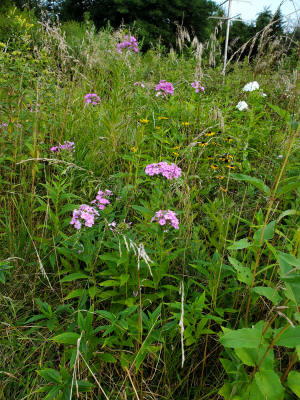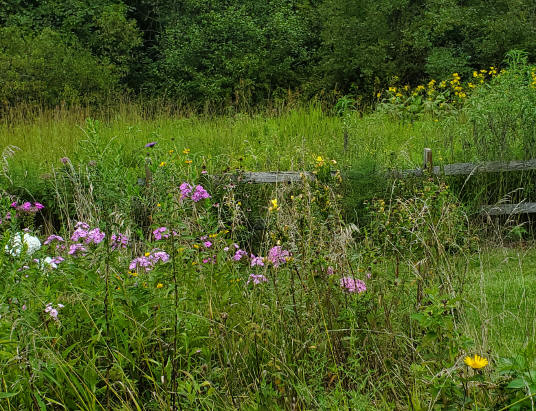Mary Ann Ryan
Adams County Master Gardener
 (9/2) When googling the definition of a meadow, several definitions come up. 1. A grassland; 2. A wild area with no trees or shrubs; 3. Land with herbaceous plant material, grasses and wildflowers.
(9/2) When googling the definition of a meadow, several definitions come up. 1. A grassland; 2. A wild area with no trees or shrubs; 3. Land with herbaceous plant material, grasses and wildflowers.
There are other definitions that delineate a field vs a meadow, what meadows mean in other countries, and whether they are in lowlands or uplands. But for the purposes of this article, I will refer to a meadow as having herbaceous plant material.
Why are meadows being suggested for residential communities? What is the advantage of a meadow? Meadows provide quite a few ecological improvements. But let’s start with where we are now in our neighborhoods ecologically.
The idea of a development, or the suburbs, started in 1946 with the planning of the first suburb, called Levittown. This suburb is on Long Island, New York and still in existence today. It was the answer to soldiers and their families as they returned from WWII. When the war ended, these communities provided a home for their families to live and own. These homes looked the same, side by side, on a small piece of land. Although these homes have changed greatly over the years, this first planned suburban community is much like many of our developments today.
These communities were a necessary answer. Not only for providing a place to live, but economically it caused a boom in building – from building supplies to labor. However, the result of the hard surfaces created by roofs, sidewalks, parking lots, roads, etc. caused erosion, pollution, and reduction in insect, plant and animal population. We know today that the increase in development has caused these issues to increase.
We can’t stop development. It is a necessary means to providing places for us to live, shop, eat, and work. However, we can control how we manage this development. We can decrease the amount of soil erosion that happens as a result of development, we can capture water, so it doesn’t run across hard surfaces, picking up pollutants and dumping those pollutants into our creeks and streams, and ultimately the bay. And one way is through meadows.
We’ve learned that monoculture, or one dominant species, does not provide a habitat for multiple critters (birds, bugs, mammals, etc.). Turf is a monoculture, and one that is not native to the US. But if we transition parts of our lawn to multiple species of plants, we can create areas for these critters. And if we connect our diverse plantings with our neighbors, then suddenly we have connected corridors for the critters to eat, nest and have their young.
We’ve learned that not only is the monoculture plant life contributing to the decline in insect life, but also increased pollution. Because the root systems of turf grass are shallow, the water runs off quickly, picking up pollutants along the way. The deep roots of our native plants allow a path for water to penetrate through the soil. This causes erosion and sediment in the creeks and rivers, which flows into the Chesapeake Bay. Not to mention the air pollution that results in lawn equipment used on a weekly, sometimes bi-weekly basis, needed to manage lawns.
How can we reduce air and water pollution, increase insect diversity, provide homes for the birds, and have a balanced ecosystem? Start by transitioning the lawn. Introduce native plants into your landscape. Reduce the amount of turf grass, reduce pesticides. Re-forest part of your yard by planting native trees and shrubs and introducing native flowering perennials. Create meadows, even if it’s just a 6’x6’ area. That’s a great start.
If you decide to move forward with a meadow, how does one go about it? There are a few steps to take for a successful meadow.

First, you must get rid of the existing plant material. This can be done a few ways:
A. Use an herbicide. Spray a non-selective herbicide, mixing according to the label, over the area you wish to transition. This is the quickest way to get rid of existing plant material. However, the use of herbicides is not always the best option, depending on the location of the proposed meadow planting.
B. Use plastic tarps over the area, weighted down by stones, bricks, or whatever you may have on hand. This will take a season to control the weeds and looks ugly but is an organic option. The plastic will need to be removed after the plant material is dead and before the new plantings are installed.
C. Use cardboard, covered in mulch or compost. This, too, will take a season but looks clean and tidy, and is organic. Caution – use cardboard that is not shiny. Take all tape, plastic, and staples off the cardboard. This cardboard will breakdown in the soil, so no need to remove it after the weeds are gone.
Step two: Determine what to plant. Plant selection will be determined by soil type, drainage and sun/shade of the area. Taking a soil test will help in plant selection.
Step three: Seeds vs Plants. Depending on the size of the area and the depth of your pockets will help determine what choice you make.
A. Starting from seeds: After choosing and ordering your mix, broadcasting the seeds with a spreader of some type is probably the easiest way to sow the seeds. If the area is small, then sprinkling the seeds by hand may be an option. Many resources recommend gently raking the ground prior to broadcasting to increase seed to soil contact. After the seed has been spread on the ground, tamping the seeds to ensure that contact is a good idea. This can be done with a roller, or if a smaller area, just walking over the seeds will work too.
After seeding, many sources recommend using a light layer of clean straw to help keep the seed in place. Then lastly, water it in.
The best timing for native perennials and grasses is to seed in the fall. Many of our native seeds require cold stratification which, when planted in the fall, would allow for the winter to provide that. If planting in the spring, it would be a good idea to add some annual seeds to cover the soil until the perennial seeds germinate. Or, put the seeds in the freezer for two months before planting.
B. The second method is to start with plants. The soil preparation will all be the same – steps one and two should be followed. This is, by far, more expensive. But if it is just a small area that is getting transitioned, then this may be a good way to go. This allows for immediate impact. This also provides the opportunity to place the plants in grouping for more impact.
Plants can be purchased as "plugs", small plants grown in trays. These are less expensive than buying quart-sized or gallon container plants. If using plugs, purchase early in the season to allow the plant to get a good root system before the heat and dryness of the summer. There are many nurseries on-line that sell plant plugs and ship them to you. And most nurseries and garden centers sell quart and gallon container plants.
Many nurseries sell native plants, but often they are cultivars of the native species. Be sure to do research to check if the cultivar provides food and nectar needed for the insects. Some cultivars do not, like the double flowering coneflowers, for example.
After planting, whether seeds or plants, be sure to keep everything watered. Mulch your newly planted plants.
Maintenance of a meadow is easy, and much less time is needed in managing a meadow as opposed to a lawn. Mow once per year in the spring. This allows the seed heads to remain for the winter birds, and the overwintering insects to hatch out. However, know that the first and second year will require more care than the third and after. It takes three years for a native herbaceous meadow to get established. Weeding will need to be on the chore list. After it’s established, by year three, then just the occasional scouting for invasive plants is needed. Also know that as a meadow matures, it will change. Some species will die out due to competition, or they just don’t like the soil or location. But other plants will come in that will do well and possibly change the look of the meadow.
When considering a meadow in your yard, be sure to know your community’s weed laws or ordinances. Often this is the biggest hindrance in a development. Let the HOA or township know what you are trying to do. Only after those making decisions know and understand your goal, can change take place.
Plant with intention. A small strip of grass surrounding a meadow, or a stone edge, or even a fence, will delineate a controlled area from a less controlled area, making it look intentional.
Consider transitioning your lawn to a meadow. Start a trend in your neighborhood. Small or large, color, insect activity, and enjoyment will increase with a diversity in plants.
Read other articles on ecological gardening & native plants
Read more
articles by Mary Ann Ryan